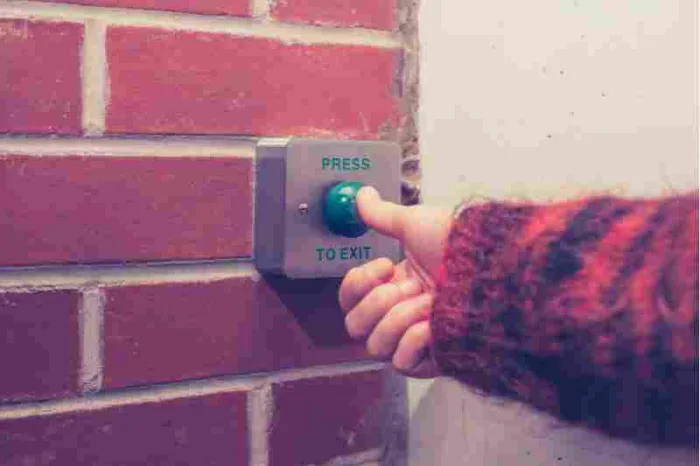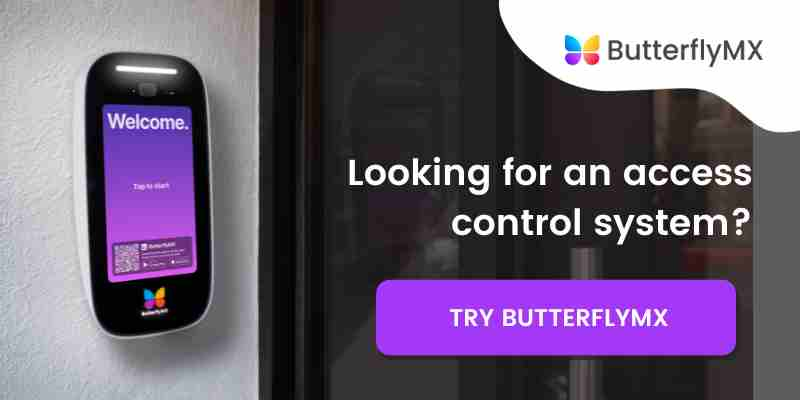Key takeaways
- A push-to-exit button makes evacuation easier for your tenants by offering them a guaranteed way to unlock the door and exit the building.
- Push-to-exit buttons work differently depending on whether the lock they control is fail-safe or fail-secure. If it’s a fail-secure lock, it’s important to connect the PTE button to a secondary power source so that residents can still open the door during an outage.
- The best way to use PTE buttons is in concert with a resilient, easy-to-use access system like ButterflyMX.

Many property managers and tenants cite physical security as one of their biggest priorities. And while securing entrances to sensitive spaces is important, you should also consider the ease of exiting these spaces. That way, access remains convenient for your tenants. One device that makes exiting a property easier is a push-to-exit button.
In this post, we explain what a push-to-exit button is and how they work. Then, we go over the best way to use them at your property.
This post covers:
- What is a push-to-exit button?
- How does a push-to-exit button work?
- The best way to use push-to-exit buttons
What is a push-to-exit button?
A push-to-exit button is a button that building tenants can press to ensure that the door they’re about to leave through is unlocked. This way, they don’t have to be granted permission to exit by a front desk worker or fumble with their keys or a PIN to exit.
Furthermore, push-to-exit buttons make leaving through certain hallways is safer in case of congestion or emergencies.
What is a push-to-exit button for?
In situations like fire drills or power outages, you must ensure that your access control system doesn’t accidentally keep doing its job. You might depend on hardware like smart readers, intercoms, or keypads to manage access into a space. But there’s no need for similar levels of security on a person’s way out.
Accidentally locking down spaces that don’t need to be locked down is a recipe for disaster. Luckily, push-to-exit buttons are here to make leaving areas and properties easier.
After all, if somebody’s already in a secure part of your building, the only way they could have gotten there is by getting their identity verified
You can install push-to-exit buttons anywhere on your property where you want to make leaving easier.
Place a push-to-exit button near places like:
- Server rooms and high-security areas
- Hallway doors, stairwells, and other areas that will serve as evacuation routes
- Gates that might prevent people from leaving the property
Note: If you’re installing your PTE button outside, look for an IP-rated push-to-exit button that can withstand the elements.
Watch how ButterflyMX works:
How does a push-to-exit button work?
A push-to-exit button works by disengaging the lock on a door so that somebody can exit through it.
These days, PTE buttons come with tons of features. You can purchase wireless push-to-exit buttons or even infrared sensor exit buttons that don’t require touch at all. But at their core, every PTE button functions the same way when you consider its role in the larger access system.
The way a push-to-exit button functions depends on the kind of lock it controls. In fact, there are two types of locks: fail-safe and fail-secure. The difference between them is how they act during a power outage.
In an outage, fail-safe locks will automatically unlock. So, they keep people safe by unlocking and allowing for easy access out of the building. This happens because fail-safe locks depend on a constant stream of power to stay locked. When they receive an unlock signal, from a keypad or a PTE button, this signal stops for a moment to allow the user to open the door.
On the other hand, fail-secure locks automatically lock. Fail-secure locks keep property secure by keeping an area locked down during an outage. Fail-secure locks only unlock after a short burst of power.
Here’s how an exit push button for access control works depending on the type of lock you have:

Fail-secure
In a fail-secure locking system, you need to make sure that the push-to-exit button for a magnetic lock is connected to a secondary power source. This way, even if the building has a power outage, the PTE button can still send bursts of power to the lock and unlock the door.
Fail-safe
Setting up an exit button for a fail-safe lock isn’t as important for the security of a building. If that door is already set up to unlock in case of a power outage, people will be able to just exit through that door without needing any electronic hardware.
However, you might want people to use the PTE button in everyday usage. In this case, all you’d have to do is connect the PTE button to the lock and your building’s electricity, and you’ll be all set.
The best way to use a push-to-exit button
While push-to-exit buttons are important, they only work in the context of a robust, successful electronic access system like ButterflyMX.
Emergency exit buttons are designed with electronic lock egress in mind. You’ve learned about the importance of PTE buttons in scenarios like evacuations or emergencies. But, hopefully, those will be rare cases. So, how can you focus on providing safe and convenient access for your tenants and their visitors during an ordinary day?
For thousands of property managers worldwide, the answer is ButterflyMX. Whether your locks are fail-safe or fail-secure, ButterflyMX stands ready to secure your property with our unified ecosystem of intercoms, smart lock integrations, keypads, and more.
Our smart access experience revolves around the convenience and security of your smartphone. After all, everybody’s got one in their pockets these days — and residents can use them to remotely unlock the door and issue Delivery Passes to couriers.
As for staff, our integrations with smart lock brands and property management software platforms will make editing permissions and managing properties easier. Further, ButterflyMX can easily be installed in tandem with PTE buttons to guarantee residents, tenants, and guests have easy access into and out of your property.






